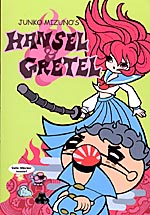 By Junko Mizuno
By Junko Mizuno
144 pages, color
Published by Viz
If you think about it, the original story of “Hansel & Gretel” isn’t terribly logical. Parents, unable to feed their children, decide that abandoning them in the middle of the forest is the answer to all their problems. (And if at first they come trapsing home, abandon them even further into the forest.) Only once they’ve avoided near-death at a witch’s hands do they come home, and all is well with their family life because now they can eat the witch’s edible candy house and not have to try and write each other off. Either these are the most-trusting, or the stupidest children in the world. Possibly both. In any event, this probably explains why in Junko Mizuno’s Hansel & Gretel, Mizuno only took a couple of specific elements she liked from the original story and threw out the rest.
Life is pretty good in the small village of Hibari-Cho. Baked goods are mined from Bread Mountain, the host of Sister Garden pulls vegetables right out of her hair, and a giant pig cuts sides of meat off of himself for people to eat. All of this goes to the food market run by Hansel and Gretel’s parents, and everyone is happy. When the sources of food suddenly dry up, though, the villagers are lured to a strange place called Foodland where everything is made out of candy. Soon, the entire town is under an evil witch’s thrall, and it comes down to Hansel and Gretel to save them all. Good thing Gretel has her sword, and Hansel his super-powered voice that can destroy things with just a whisper. They’ll need them to stop a chilling face from their past!
As mentioned earlier, Mizuno isn’t providing a direct adaption of the original “Hansel & Gretel”, but instead is just using specific elements from the fairy tale. I think this is a good move; not only does it keep Mizuno from getting trapped into a specific storyline, but it frees up her bizarre imagination in the best possible way. The story itself is pretty linear and a little repetitious in the middle section (one almost imagines a big checklist of which people Hansel and Gretel still need to visit before going to the final location for the conclusion), but the strange situations and ideas on display here keep it from getting old.
I’m sure there are those out there nothing short of terrified of her twisted art, but I think it’s wonderful; this is the sort of story that really will appeal to today’s children, while still having a lot to offer to adults. Let’s face it, kids like both the cute and gruesome, and this is a perfect combination of the two. For instance, Mizuno gives us a cute, gigantic pig… that’s slicing off part of his stomach for people to eat. Add in what looks like the cast of “Sailor Moon” turning into huge grotesque monsters and beating the tar out of each other, and you’ve got a pretty good idea of just what you’re going to see in Hansel & Gretel. I was really happy to see that the colors are much brighter here than in Cinderalla (which felt a little washed out); with all of these shocking, in-your-face colors leaping off the page and her crisp lines giving everyone such an innocent look, Mizuno’s able to make her book look even more like an adorable children’s story… and thus, make sure that the over-the-top aspects of the book are all the more jarring to the unexpecting reader.
The second of Mizuno’s fairy-tale adaptations, reading Hansel & Gretel will just make you hope that we get more such volumes from Mizuno, and soon! Viz has done a great job with packaging this book—the sticker pages at the end are such a wonderful touch—that I’ve already found myself buying copies for various friends’s birthdays. Mizuno fans will already know to buy this book, but for those who like twisted humor and art, you really need to get this as well. Trust me, you’re about to be inducted into the cult of Mizuno as well. (Just don’t drink the green punch unless you have a strong stomach.)
